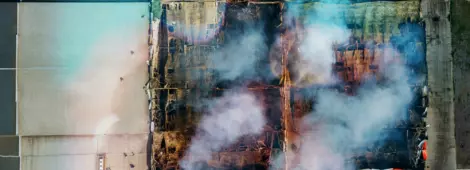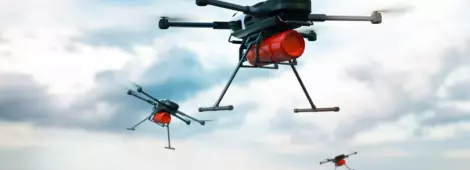
NEW TECHNOLOGY AVAILABLE TO THE FIRE INVESTIGATOR
by Mugtaba Lazim
Although more familiar to fire investigators, traditional investigation tools can be time-consuming to use and may not always produce optimal results. New technologies offer forensic fire investigators a wide range of equipment to enhance and accelerate the documentation of fire scenes as well as the detection, collection, and preservation of evidence.
Documentation Equipment
Laser scanners have revolutionised the way fire scenes are reconstructed. This powerful tool uses infrared technology to digitally record a scene and capture millions of data points (point cloud data) within a matter of minutes. Data points can then be extracted to produce a 3D model allowing the investigator and other parties to “return to the scene” even after the physical scene has been demolished.
With modern technology, investigators can carry the capabilities of 3D modelling on their mobile phones. 2020 saw the introduction of LiDAR (Light Detection and Ranging) technology on certain models of iPhones, which allows the user to scan an area and produce a 3D model within apps. Measurements and other information can be taken from the 3D models and analysed to support an investigation.
Drone technology has also become an important tool in the investigation process. With the aid of drones, scenes can be examined using high-definition cameras controlled by an operator safely outside the hazard zone. Viewing a fire scene from an aerial point of view also allows the investigator to analyse fire spread across the scene from a wide angle.
Detection Equipment
Technological advancements in the field of “portable sniffers” have led to the development of battery-powered, handheld devices capable of detecting ignitable liquids and generating lab-quality data at fire scenes. Photoionisation detectors (PIDs) and portable Gas Chromatograph/Mass Spectrometers (GC/MS) can detect and test residual traces of hundreds of gases and vapours. With sensitivity down to a few parts per billion (ppb), they are quick, simple and accurate methods for detecting volatile hydrocarbons at a fire scene. In comparison, the human nose has a threshold for petrol of around one part per million (ppm). One benefit of instrumentation use at fire scenes is that it vastly reduces the amount of evidence removed from the scene, limiting the possibility of cross-contamination
and errors in chain of custody.
Also, with the rapid processing capabilities of portable sniffer devices, results are generated quickly allowing investigators to form a working hypothesis of cause. However, the results provided by these devices are not sufficient for court purposes and all samples should be subject to a laboratory analysis to ensure the reliability of the results.
Evidence Collection and Preservation Equipment
To maintain the integrity of evidence, investigators must protect it from destruction, alteration, damage and contamination. Fire investigation kits are commonly available to investigators to assist with the collection, documentation and packaging of evidence. These kits provide essential tools like disposable pipettes and syringes, glass jars of various sizes, paper bags, and evidence labels.
New advancements in x-ray technology have also broadened forensic fire investigator capabilities. Portable x-ray devices like the ADX600 allow investigators to capture internal images of fire-damaged items (e.g., melted masses of plastic) and find any points of failure not readily visible. X-ray systems enable investigators to non-destructively and repeatedly examine items without loss of evidence.
Every fire and explosion scene presents its own unique challenges. The application of new technology in field investigations is not intended to overshadow traditional means of fire and explosion investigation. Rather, it is a means of supplementing the investigation process to reliably document, collect and preserve evidence. New technology can further enhance the level of certainty in forensic fire investigations, which is needed to support successful claims processes.












